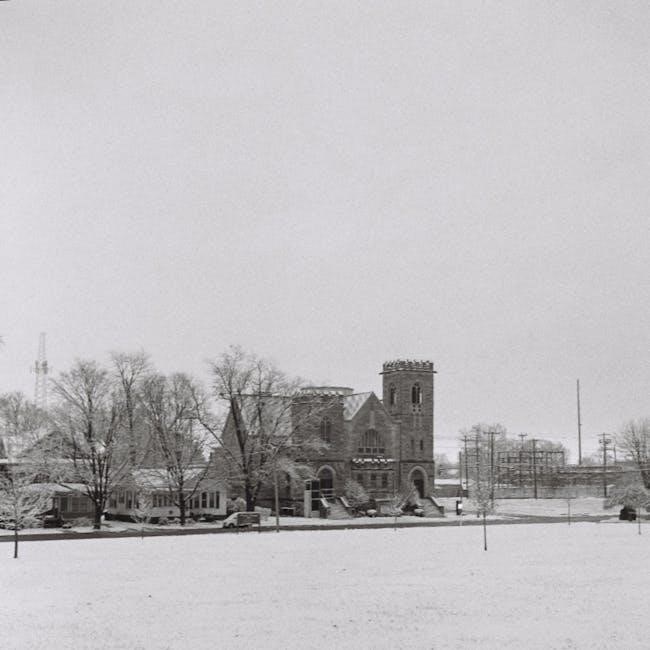The Seventh-day Adventist Church Manual serves as a comprehensive guide for church governance, operations, and functions, ensuring order and unity across all local churches worldwide․
Overview of the Church Manual
The Seventh-day Adventist Church Manual is a detailed guide outlining the structure, functions, and operations of local churches within the denomination․ It covers essential topics such as church governance, membership requirements, baptism procedures, disciplinary measures, and the roles of church officers․ The manual also addresses the organization of departments and committees, elections, and worship services․ Based on biblical principles and the writings of Ellen White, it provides a framework for maintaining order and unity across the global church․ Regularly updated by the General Conference, the manual ensures that church practices remain aligned with Adventist beliefs and mission․ It serves as an indispensable resource for church leaders and members alike, promoting consistency and harmony in church operations worldwide․

Purpose and Importance of the Church Manual
The Church Manual ensures order, unity, and consistency in church operations, reflecting biblical principles and Ellen White’s writings, while guiding members toward spiritual growth and harmonious church life․

Biblical Basis for Church Governance
The Seventh-day Adventist Church Manual is deeply rooted in biblical principles, emphasizing God’s nature as a God of order․ This is evident in creation and redemption, where structure and harmony prevail․ The manual aligns with Scripture, such as 1 Corinthians 14:40, which calls for orderly conduct, and Colossians 2:5, highlighting the importance of church discipline․ It reflects the organizational patterns of the early Christian church, including the roles of elders and deacons․ By adhering to these biblical foundations, the Church Manual ensures that governance and practices are consistent with God’s will, fostering unity and spiritual growth among members․
Structure and Organization of the S․D․A Church
The Seventh-day Adventist Church operates through a hierarchical structure, with local churches connected to conferences, unions, and divisions, ensuring unity and collective responsibility globally․
Departments and Committees Within the Church
The Seventh-day Adventist Church is organized into various departments and committees to ensure effective ministry and governance․ Departments such as Sabbath School, Youth Ministries, Women’s Ministries, and Family Ministries focus on specific areas of church life․ These departments are designed to promote spiritual growth, community engagement, and outreach․ Committees, such as the Church Board and Finance Committee, oversee administrative and financial matters, ensuring transparency and accountability․ Together, these groups work to maintain order and efficiency, enabling the church to fulfill its mission effectively․ Their functions are detailed in the Church Manual, providing clear guidelines for operation and decision-making processes․

Membership and Baptism
Membership in the Seventh-day Adventist Church is essential for active participation in church life․ Baptism is a sacred ritual symbolizing a believer’s commitment to Christ and His teachings․ Prospective members must affirm their belief in Adventist doctrines and demonstrate a life aligned with biblical principles․ The Church Manual outlines specific requirements and procedures for membership and baptism, ensuring consistency and spiritual integrity across all congregations․ These processes are designed to foster a deep connection with Christ and the church community, strengthening individual faith and collective worship․
Process of Becoming a Church Member
Becoming a member of the Seventh-day Adventist Church involves a structured process outlined in the Church Manual․ Prospective members must study Adventist doctrines, attend preparatory classes, and demonstrate a commitment to the church’s beliefs․ They undergo a personal interview with church officers to affirm their faith and understanding․ Following this, the church board reviews and approves the membership request through a vote․ Finally, members are welcomed through baptism or a public profession of faith, solidifying their covenant with the church community․ This process ensures that individuals are well-prepared and committed to the Adventist faith, fostering spiritual growth and unity within the congregation․
Church Discipline
The Church Manual outlines principles for addressing misconduct, emphasizing biblical order and unity․ It provides guidelines for handling disciplinary issues in a loving, redemptive manner, based on Scripture․

Procedures for Addressing Misconduct
The Church Manual provides a structured approach to addressing misconduct within the church․ It emphasizes biblical principles of restoration and accountability, ensuring matters are handled with fairness and compassion․ Procedures typically involve private admonition, followed by church leadership intervention if necessary․ The manual outlines steps for investigation, counseling, and, when required, disciplinary actions such as censure or exclusion․ These processes aim to maintain unity, protect the church’s integrity, and promote spiritual growth among members․ The goal is to resolve issues in a manner consistent with Christ’s teachings of love and redemption․

Role of Officers and Leadership
The Church Manual defines the roles of pastors and church employees, emphasizing spiritual guidance, administrative support, and fostering unity to ensure effective church operations and harmony․
Responsibilities of Pastors and Church Employees
Pastors and church employees play a vital role in guiding the spiritual and administrative functions of the church․ Pastors are responsible for preaching, baptizing, and providing spiritual counsel, while also overseeing church services and ministries․ Church employees assist in managing day-to-day operations, ensuring efficiency and adherence to the Church Manual․ Their duties include organizing events, maintaining records, and supporting the congregation’s needs․ Both pastors and employees must uphold biblical principles and the teachings of Ellen White, fostering a cohesive and orderly church environment․ The Church Manual provides detailed guidance to help them fulfill their roles effectively, ensuring harmony and growth within the church community․
Historical Development of the Church Manual
The Seventh-day Adventist Church Manual was first published in 1932 and has undergone revisions over the years, with significant updates in 2015 and 2022;
Updates and Revisions Over the Years
The Church Manual has been periodically updated to reflect the evolving needs and practices of the Seventh-day Adventist Church․ In 1932, the first official manual was published, establishing foundational guidelines․ Over the decades, revisions have been made to address changing circumstances, such as advancements in technology and shifts in societal norms․ Notably, in 2015, an amendment was unintentionally excluded, prompting corrections in later editions․ The most recent revision was in 2022, ensuring alignment with current church policies and Ellen White’s writings․ These updates maintain the manual’s relevance and effectiveness in guiding church operations worldwide․
The Church Manual is essential for effectively guiding local churches, ensuring order, unity, and effective governance, aligning with the church’s mission and fostering spiritual growth․
The Essential Role of the Church Manual in S․D․A Governance
The Church Manual is a foundational document guiding the governance and operations of the Seventh-day Adventist Church․ It ensures unity, order, and consistency across all churches globally․ By aligning with biblical principles and the writings of Ellen White, the manual provides clear policies for membership, discipline, and leadership roles․ It fosters a structured yet flexible framework for church administration, ensuring that all decisions and practices reflect the church’s mission and values․ Regular updates keep the manual relevant, addressing contemporary challenges while maintaining the church’s historical integrity․ Thus, it remains an indispensable tool for effective governance and spiritual growth within the Adventist community․



